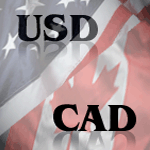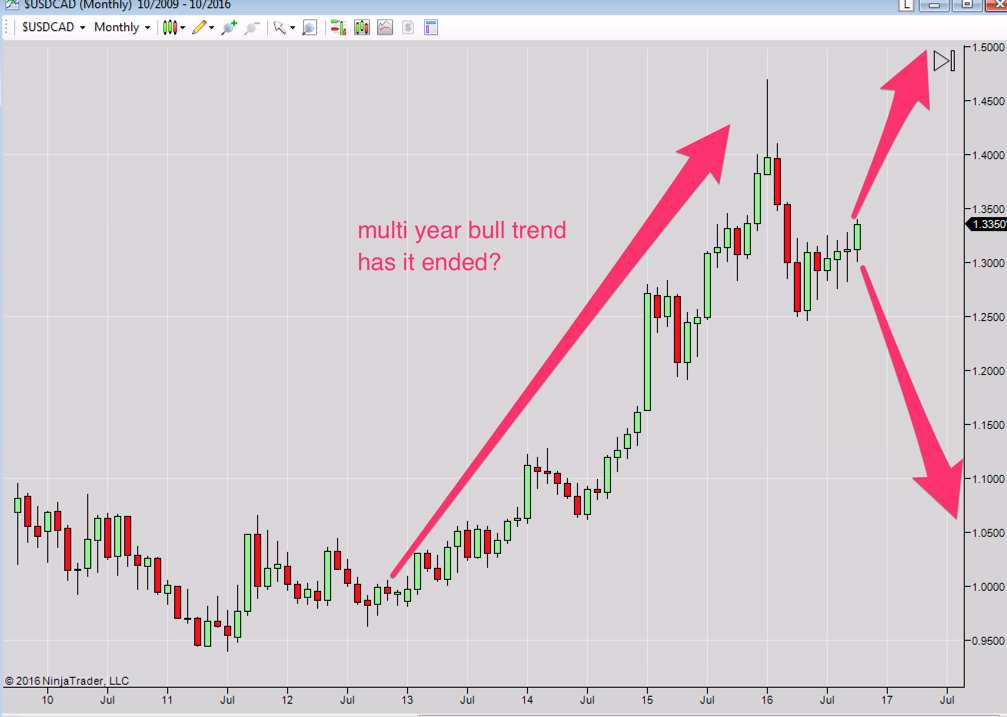Spread Betting: Trading USD/CAD
 The two countries are very close physically, sharing a border, but there are some fundamental differences between the US economy and the Canadian one which you need to appreciate when trading the USD/CAD. The Canadian outlook is much more calm and similar to the European one, whereas the US economy is driven hard by consumerism.
The two countries are very close physically, sharing a border, but there are some fundamental differences between the US economy and the Canadian one which you need to appreciate when trading the USD/CAD. The Canadian outlook is much more calm and similar to the European one, whereas the US economy is driven hard by consumerism.
Some would say it’s not for nothing that the term “loonie” has been coined for the Canadian currency exchange. Canada is an immense country, replete with natural resources for which the United States is a major customer. The country is the third-largest gas producer globally and has reserves of about 1300 trillion cubic feet or 37 trillion cubic metres in natural gas resources. Canada also ranks third globally in its oil reserves with 173 billion barrels, 98% or 169 billion barrels of which consist of oil sands and with new extraction technology oil sands reserves may increase even further. The country is also one of the world’s biggest producers of uranium. Canada also contributes a significant amount of timber and other commodities, of which the latest is talk of piping oil through the middle of the United States to the refineries on the Gulf coast.

How will the Canadian dollar do against the US dollar in the next year? USDCAD is a multiple year bull trend which shows both signs of trend continuation and trend exhaustion. At present the market is going up, but it is going up in a fashion where it is going up slower and weaker than the previous downmove. The large upper wick on the top candle indicates the market not liking fresh highs, and the 3 subsequent down months indicate significant selling pressure. This would be a good example of a market to stand aside from trading. Right now the odds slightly favour further upside, but any potential weakness would likely set off a chain reaction of selling. Call it a coin flip – sorry 🙂
Fundamentals
Despite the global economic downturn, Canada has remained slightly less stressed than the States, and this is reflected in its economic outlook. Whenever oil is increasing in value, that tends to be a bullish sign for the Canadian dollar. However, there is still talk in Canada of a “housing bubble”, which would tend to lessen the Canadian dollar in relationship to the US currency.
No matter when you are reading this, there are sure to be numerous factors and rumours surrounding both economies, which might reasonably be expected to influence the USD/CAD exchange rate. These are factors that affect most developed countries and their relationship to other monetary systems.
From a fundamental view point, the state of employment, the wealth of the nation, and its trading relationship with other partners are key elements. Firstly, the state of employment is regularly updated by reports of jobless claims, productivity, typical overtime, and other factors. In basic terms, if a country’s workforce is gainfully employed to a large extent, the economy can be considered healthy, which corresponds to a bullish position on the currency. In other words, investors are happy to put their money in the country.
The second gauge, the wealth of the nation, is not quite the same thing. The employment figures give some indication of the amount of income available, but the wealth of the nation includes how rich people feel, whether they are saving or feeling secure and spending on luxuries, and how happy they are to be spending money, a necessary action for the economy to thrive.
While the first two are basically internal factors, the third item includes trading relationships with other countries as well as imponderables such as how the nation is viewed from the outside. The most obvious measurable data is the balance of trades, the total of the imports and exports, and whether these amounts are one-sided or balanced. Obviously, if it is one-sided and goods need to be paid for, that introduces more pressure on the currency exchange.
It is worth noting that the Canadian dollar is traditionally correlated with the oil price. Since it can be quite expensive to extract oil in Canada, this correlation is even strong when oil prices move above the $80 mark.
It is often said that when trading or spread betting you should favour the overall trend of the market, as this increases your chances of a good outcome. The factors enumerated above will give you an indication of the overall trend, but you must be sure to study the technical indicators for clues about where the market is going in next few days or weeks. Spread trading is a short-term method of betting, with limited time frames, and it is essential to time your bets in tune with the charts.
Spread Betting the USD/CAD
The US dollar and the Canadian dollar are closely tied together because of the amount of trade which takes place between these neighbouring nations. The exchange rate tends to float around parity, but depends on the particular circumstances of each country’s economy. The current spread betting quote is 10,073.5 – 10,077.0. A long or buy bet would mean that you think the US dollar is going up in relation to the Canadian dollar, or in other words the Canadian dollar is going to weaken. If you think the Canadian dollar is going to strengthen/the US dollar weaken, then you would place a short or sell bet.
For example, if you favour the US economy you could place a buy bet for £12.50 per point. At the moment, that would be placed at 10,077.0. If we assume that the US dollar does strengthen against the Canadian dollar, the quote may go up to 10,292.1 – 10,295.6. If you close your bet at this point, you can work out your winnings like this: –
- Your buy bet was placed at 10,077.0
- Your bet was closed at 10,292.1, the selling price
- The number of points you gained is 10,292.1 less 10,077.0
- The total number of points is 215.1
- Because you placed a bet for £12.50 per point, that means you won £2688.75
Of course, you cannot expect all your bets to win, and if the price went down after you placed this bet you would have to decide at some point to close the bet and accept your loss. Say this was when the quote went down to 10,021.9 – 10,025.4.
- Your buy bet was placed at 10,077.0
- Your bet was closed at 10,021.9, the selling price
- The number of points you lost was 10,077.0-10,021.9, a total of 55.1 points
- Because you placed a bet for £12.50 per point, that means you lost £688.75
An important lesson in betting or trading is that you cut your losses as soon as you realize that it won’t work out, so that you do not lose too much of your capital.
Look now at an example of the opposite – one where the Canadian economy picks up, or the US slumps, which means this currency pair will go down. You could bet £9 per point at the selling price of 10,073.5. If the spread betting quote goes down, you might close your bet for a profit when it reaches 9956.2 – 9959.7. As you wanted it to go down, you win the difference in points times your stake.
You put your bet on at 10,073.5, and it closed at 9959.7, the buying price as this was a short bet. That means you won a total of 113.8 points. Multiplying by your stake of £9, your total winnings are £1024.20.
Once again, you must realize that you could have lost the bet. Say the currency went up to 10,103.2 – 10,106.7, and you closed the bet and accepted your loss. This time the point difference is 10,106.7 less 10,073.5, which is 33.2 points. This amounts to a total loss of £298.80.


Join the discussion